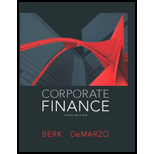
Corporate Finance
3rd Edition
ISBN: 9780132992473
Author: Jonathan Berk, Peter DeMarzo
Publisher: Prentice Hall
expand_more
expand_more
format_list_bulleted
Question
Chapter 23, Problem 1P
Summary Introduction
To determine: The alternative sources from which private companies can raise equity capital.
Introduction:
Equity capital is the portion of the firm capital; these capital funds are paid into a business firm by an investor in exchange for shares of ownership in the company.
Expert Solution & Answer
Explanation of Solution
The alternative sources from which private companies can raise equity capital are as follows:
- Venture capitalist: An investor who provides capital to a start-up business firm or gives their support to small companies to expand their business is a venture capitalist.
- Institutional investor: Institution investors are those organizations which invest on the behalf of the investor. These institutions are investment banks, money managers, hedge-fund investors, commercial trusts, and various others.
- Angel investor: An investor who provides the capital for a start-up business firm, usually in exchange for convertible debt or ownership equity is an angel investor.
- Corporate investors: A company that invests in other companies to control the business and increase their profit is a corporate investor.
Want to see more full solutions like this?
Subscribe now to access step-by-step solutions to millions of textbook problems written by subject matter experts!
Students have asked these similar questions
The net present value (NPV) of a project is:A) The difference between total cash inflows and total cash outflows over the project’s lifeB) The sum of discounted cash flows, less the initial investmentC) The discount rate at which the project’s NPV is zeroD) The payback period for recovering the initial investment
explain.
The net present value (NPV) of a project is:A) The difference between total cash inflows and total cash outflows over the project’s lifeB) The sum of discounted cash flows, less the initial investmentC) The discount rate at which the project’s NPV is zeroD) The payback period for recovering the initial investment
A bond selling at a price above its face value is said to be selling at:A) ParB) A discountC) A premiumD) Fair valueexplain
Chapter 23 Solutions
Corporate Finance
Ch. 23.1 - Prob. 1CCCh. 23.1 - Prob. 2CCCh. 23.2 - Prob. 1CCCh. 23.2 - Prob. 2CCCh. 23.3 - List and discuss four characteristics about IPOs...Ch. 23.3 - Prob. 2CCCh. 23.4 - Prob. 1CCCh. 23.4 - What is the average stock price reaction to an...Ch. 23 - Prob. 1PCh. 23 - What are the advantages and the disadvantages to a...
Ch. 23 - Prob. 3PCh. 23 - Suppose venture capital firm GSB partners raised...Ch. 23 - Prob. 5PCh. 23 - Prob. 6PCh. 23 - Prob. 7PCh. 23 - Prob. 8PCh. 23 - Prob. 9PCh. 23 - Prob. 10PCh. 23 - Prob. 11PCh. 23 - Prob. 12PCh. 23 - Prob. 13PCh. 23 - Prob. 14PCh. 23 - Prob. 15PCh. 23 - Prob. 16PCh. 23 - Prob. 17P
Knowledge Booster
Similar questions
- What does the beta of a stock measure?A) The stock’s volatility relative to the marketB) The stock’s dividend yieldC) The stock’s return on equityD) The stock’s earnings per share no ai.arrow_forwardWhat does the beta of a stock measure?A) The stock’s volatility relative to the marketB) The stock’s dividend yieldC) The stock’s return on equityD) The stock’s earnings per sharearrow_forwardPlease help with questionsarrow_forward
- A bond selling at a price above its face value is said to be selling at:A) ParB) A discountC) A premiumD) Fair valuearrow_forwardWhich of the following is an example of a capital budgeting decision?A) Issuing bonds to raise fundsB) Choosing to repurchase company stockC) Deciding to expand into a new marketD) Setting the company's dividend policy explain.arrow_forward1. What is the project’s MIRR? R = 10.00% Year 0 1 2 3 4 Cash Flows -$675 $300 $320 $340 $360arrow_forward
- how to caculate NVP?arrow_forwardWhich of the following is an example of a capital budgeting decision?A) Issuing bonds to raise fundsB) Choosing to repurchase company stockC) Deciding to expand into a new marketD) Setting the company's dividend policyarrow_forwardAn insured purchased a 15-year level term life insurance policy with a face amount of $100,000. The policy contained an accidental death rider, offering a double indemnity benefit. The insured was severely injured in an auto accident, and after 10 weeks of hospitalization, died from the injuries. How much will the beneficiary receive from the policy?arrow_forward
- I need assistance in this problem. thanks.arrow_forwardPlease help with questionsarrow_forwardEthical dilemma: Republic Communications Corporation (RCC) has offered you an attractive position in its financial planning division. The new position would constitute a promotion with a $30,000 increase in salary compared to the job you now have at National Telecommunications, Inc. (NTI). The problem is that RCC wants you to bring the rate-setting software you developed at NTI, along with some rate data, with you to the new job. Even though NTI sells its software to other companies and information concerning telephone rates is available to the public, you know that such knowledge will help RCC significantly in its attempt to redesign its rate-setting system. In fact, according to the situation presented in the text, a new and improved rate-setting program could be worth as much as $200 million per year for RCC. Therefore, the question is whether the information RCC wants you to take with you to your new job is proprietary to NTI. Should the rate-setting program and the rate data be…arrow_forward
arrow_back_ios
SEE MORE QUESTIONS
arrow_forward_ios
Recommended textbooks for you
 Intermediate Financial Management (MindTap Course...FinanceISBN:9781337395083Author:Eugene F. Brigham, Phillip R. DavesPublisher:Cengage Learning
Intermediate Financial Management (MindTap Course...FinanceISBN:9781337395083Author:Eugene F. Brigham, Phillip R. DavesPublisher:Cengage Learning EBK CONTEMPORARY FINANCIAL MANAGEMENTFinanceISBN:9781337514835Author:MOYERPublisher:CENGAGE LEARNING - CONSIGNMENT
EBK CONTEMPORARY FINANCIAL MANAGEMENTFinanceISBN:9781337514835Author:MOYERPublisher:CENGAGE LEARNING - CONSIGNMENT- Principles of Accounting Volume 1AccountingISBN:9781947172685Author:OpenStaxPublisher:OpenStax College

Intermediate Financial Management (MindTap Course...
Finance
ISBN:9781337395083
Author:Eugene F. Brigham, Phillip R. Daves
Publisher:Cengage Learning


EBK CONTEMPORARY FINANCIAL MANAGEMENT
Finance
ISBN:9781337514835
Author:MOYER
Publisher:CENGAGE LEARNING - CONSIGNMENT

Principles of Accounting Volume 1
Accounting
ISBN:9781947172685
Author:OpenStax
Publisher:OpenStax College